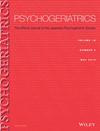脑室、脑脊液与认知:叙述性回顾
IF 1.7
4区 医学
Q3 GERIATRICS & GERONTOLOGY
引用次数: 2
摘要
脑室是自古以来就与认知有关的结构。它们是大脑功能发育和维持的重要组成部分。衰老过程伴随着心室的增大,与选择性较低的血脑屏障和毒性更强的脑脊液环境有关。将脑室作为衰老的生物标志物的研究很有前景,因为它们是神经影像学研究中容易识别的结构,具有良好的评分可靠性,并且它们的测量可以比皮层结构更早地识别脑萎缩。心室系统也在痴呆症的发展中发挥作用,因为β淀粉样蛋白清除功能障碍是散发性阿尔茨海默病的关键机制。脑室的形态计量学和容量研究有助于区分健康的老年人和轻度认知障碍(MCI)和痴呆症患者。在临床试验中,脑室数据可能有助于将个体适当分配到MCI痴呆进展风险较高的群体中,并有助于测量这些研究中的治疗反应,以及提供鉴别诊断,如常压脑积水。在这里,我们回顾了健康衰老和认知能力下降的病理生理学,重点是脉络丛和脑室在这一过程中的作用。本文章由计算机程序翻译,如有差异,请以英文原文为准。
Brain ventricles, CSF and cognition: a narrative review
The brain ventricles are structures that have been related to cognition since antiquity. They are essential components in the development and maintenance of brain functions. The aging process runs with the enlargement of ventricles and is related to a less selective blood‐cerebrospinal fluid barrier and then a more toxic cerebrospinal fluid environment. The study of brain ventricles as a biological marker of aging is promissing because they are structures easily identified in neuroimaging studies, present good inter‐rater reliability, and measures of them can identify brain atrophy earlier than cortical structures. The ventricular system also plays roles in the development of dementia, since dysfunction in the clearance of beta‐amyloid protein is a key mechanism in sporadic Alzheimer's disease. The morphometric and volumetric studies of the brain ventricles can help to distinguish between healthy elderly and persons with mild cognitive impairment (MCI) and dementia. Brain ventricle data may contribute to the appropriate allocation of individuals in groups at higher risk for MCI‐dementia progression in clinical trials and to measuring therapeutic responses in these studies, as well as providing differential diagnosis, such as normal pressure hydrocephalus. Here, we reviewed the pathophysiology of healthy aging and cognitive decline, focusing on the role of the choroid plexus and brain ventricles in this process.
求助全文
通过发布文献求助,成功后即可免费获取论文全文。
去求助
来源期刊

Psychogeriatrics
Medicine-Geriatrics and Gerontology
CiteScore
3.60
自引率
5.00%
发文量
115
审稿时长
>12 weeks
期刊介绍:
Psychogeriatrics is an international journal sponsored by the Japanese Psychogeriatric Society and publishes peer-reviewed original papers dealing with all aspects of psychogeriatrics and related fields
The Journal encourages articles with gerontopsychiatric, neurobiological, genetic, diagnostic, social-psychiatric, health-political, psychological or psychotherapeutic content. Themes can be illuminated through basic science, clinical (human and animal) studies, case studies, epidemiological or humanistic research
 求助内容:
求助内容: 应助结果提醒方式:
应助结果提醒方式:


